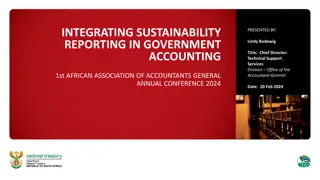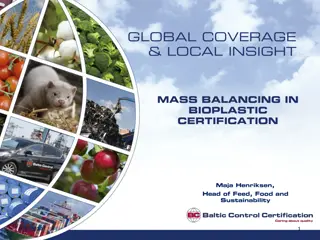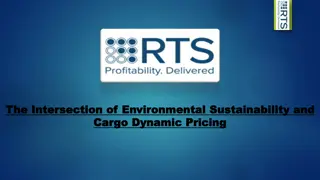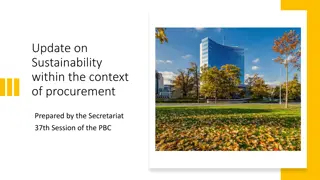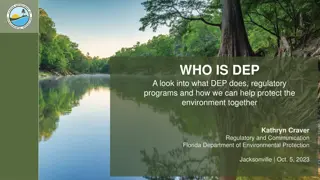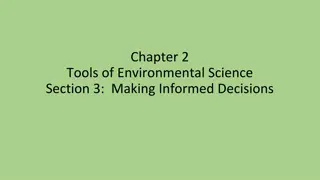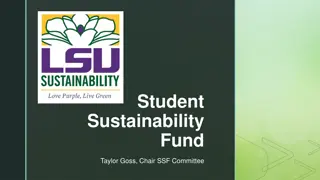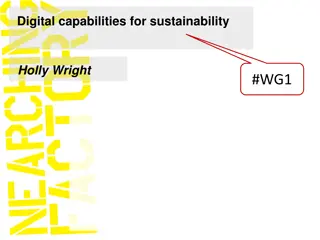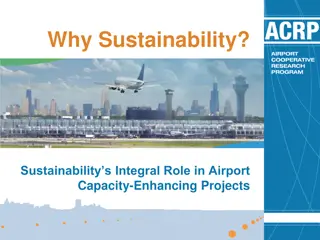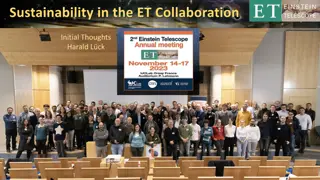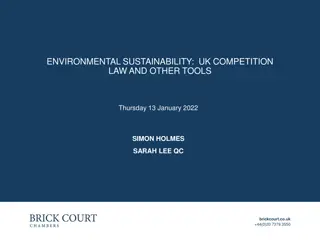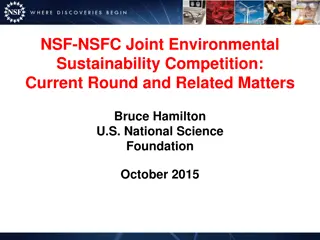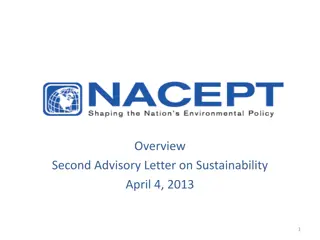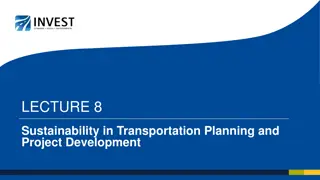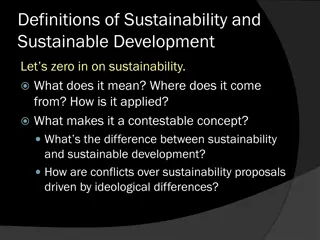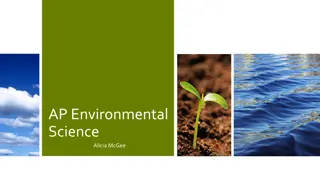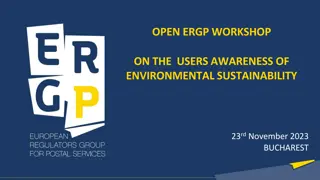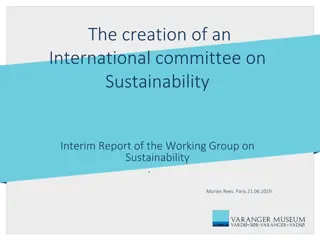Introduction to Environmental Science and Sustainability
Environmental science explores the relationships between living organisms and their environment, emphasizing sustainability and the preservation of natural resources. Key topics include ecological diversity, renewable resources, biodiversity, and the implications of scientific principles for sustainability. Environmental problems are addressed, focusing on causes like population growth, wasteful resource use, poverty, poor environmental accounting, and ecological ignorance.
Download Presentation

Please find below an Image/Link to download the presentation.
The content on the website is provided AS IS for your information and personal use only. It may not be sold, licensed, or shared on other websites without obtaining consent from the author.If you encounter any issues during the download, it is possible that the publisher has removed the file from their server.
You are allowed to download the files provided on this website for personal or commercial use, subject to the condition that they are used lawfully. All files are the property of their respective owners.
The content on the website is provided AS IS for your information and personal use only. It may not be sold, licensed, or shared on other websites without obtaining consent from the author.
E N D
Presentation Transcript
APES INTRODUCTION TO AP ENVIRONMENTAL
INTRODUCTION TO ENVIRONMENTAL SCIENCE Environment External conditions that affect living organisms Ecology Study of relationships between living organisms and their environment Environmental Science how nature works. how the environment effects us. how we effect the environment. how we can live more sustainably without degrading our life-support system.
Sustainability The ability of a specified system to survive and function over time * It is our obligation to create sustainability * Environmentally sustainable societies meets basic needs of its people in a just and equitable manner without degrading the natural capital that supplies these resources.
Four Scientific Principles of Sustainability: Reliance on Solar Energy Biodiversity Population Control Nutrient Recycling Figure 1-16
Implications of the Four Scientific Principles of Sustainability
Resources Potentially Renewable Renewable Non-Renewable Direct solar energy Fossil fuels Fresh air Winds, tides, flowing water Metallic minerals (iron, copper, aluminum) Fresh water Nonmetallic minerals (clay, sand, phosphates) Fertile soil Plants and animals (biodiversity)
Biodiversity Genetic Diversity Variety in a genetic makeup among individuals within a single species Species Diversity Variety among the species or distinct types of living organisms found in different habitats of the planet Ecological Diversity Variety of forests, deserts, grasslands, streams, lakes, oceans, wetlands, and other communities
ENVIRONMENTAL PROBLEMS: CAUSES AND CONNECTIONS The major causes of environmental problems are: Population growth Wasteful resource use Poverty Poor environmental accounting Ecological ignorance
Pollution Any addition to air, water, soil, or food that threatens the health, survival, or activities of humans or other living organisms Solid, liquid, or gaseous by-products or wastes
Environmental Degradation Common Property Resources Tragedy of the Commons Resources owned by none, but available to all users free of charge May convert potentially renewable resources into nonrenewable resources
Four Global Trends 1. Population growth and increasing consumption 2. Degradation of soils 3. Global atmospheric changes 4. Loss of biodiversity
1. POPULATION GROWTH ? Black Death the Plague Time Industrial Revolution Hunting and Gathering Agricultural revolution Fig. 1-1, p. 6
2. Degradation of Soils Fertile soil is the foundation for plant growth and food production BUT-- soils are being degraded by erosion , overgrazing, development
3. Global Atmospheric Changes Burning fossil fuels ( oil, natural gas , and coal) has caused increases in global carbon dioxide CO2 blocks infrared radiation and therefore traps heat in the atmospheric resulting in displacement of plants, rise in sea level, changes in climate and weather
CO2 blocks infrared radiation and therefore traps heat in the atmospheric resulting in displacement of plants, rise in sea level, changes in climate and weather
4. Loss of Biodiversity Increasing population and increasing consumption are accelerating conversion of forests, grasslands, and wetlands, etc. to agriculture and urban development
Why is Biodiversity is important? Mainstay of crops and medicine development Critical factor in maintaining stability of natural systems For aesthetic and moral reasons
What are ecological footprints? Ecological footprints measure the extent to which humans are using the Earth s bioproductive capacity Units are global hectares A hectare of land with average bio-productive capacity (for agriculture, forest, nutrient cycling, energy production, etc.) A hectare = 2.5 acres (1 acre is about a football field between the 5 yard lines) (1 hectare is 2 complete football fields with endzones)
Ecological footprints measure Earths carrying capacity for humans In 2010, the biosphere had about 11.5 billion hectares of biologically productive surface (about 1/4 of the total planet) 2 billion ha of ocean (the continental shelves) 9.5 billion ha of land Current estimates indicate that humans are over-shooting the Earth s carrying capacity by 25-50% To sustain the current carrying capacity, we could need 11/2 Earths! But, population growth and increasing development means that we are increasing our use of Earth s carrying-capacity (bio-capacity)
Our Ecological Footprint Humanity s ecological footprint has exceeded earths ecological capacity. Figure 1-7
What is the Tragedy of the Commons? ARTICLE: published in 1968 by Garrett Hardin. CONCEPT: a shared resource in which any given user reaps the full benefit of his/her personal use, while the losses are distributed amongst all users. Result? Tragedy all around. CLASSIC EXAMPLE: cows on shared pasture. Individuals are motivated to add to their flocks to increase personal wealth.
Tragedy of the Commons As a result, the commons were overgrazed and degenerated to the point that they were no longer able to support the villagers' cattle. This failure to preserve the natural resources is known as "the tragedy of the commons."
Common Resources AIR WATER OCEANS FISH




